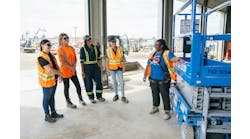Construction spending increased 0.7 percent in October to $802.3 billion at a seasonally adjusted annual rate, but was down 9.3 percent from October 2009, the Census Bureau reported last week.
Monthly gains appeared in public construction (up 0.4 percent for the month and 2.2 percent year-over-year); power (8.8 percent and -3.9 percent); private transportation such as trucking, rail and airline investments (2.7 percent and -2.6 percent), new private multi-family (3.2 percent and -33 percent); and private improvements to existing residential property (6.2 percent and -11 percent). Total private residential spending increased 2.5 percent for the month but fell 9.2 percent over 12 months, as new single-family construction slipped 1.2 percent, the sixth straight monthly drop, and 3.0 percent year-over-year. Despite the monthly increases in power and transportation, private nonresidential spending slumped 0.7 percent for the month and 21 percent year-over-year, with yearly declines in all 11 Census components.
“Without any upward trend in key private-sector construction components like homes and office buildings, it is hard to feel optimistic about the near future,” said Ken Simonson, chief economist for the Associated General Contractors of America. “With public construction at risk of cutbacks, it is premature to conclude that construction has awakened from its long nightmare.”
Association officials said that a proposal released last week by the Deficit Commission to increase investments in highways, bridges and transit system construction provided some room for optimism. It urged Congress to embrace the transportation proposal, noting it would help the economy over the long run while giving a much-needed boost to short-term construction demand.
“The best way to reduce the deficit and simultaneously support a strong and expanding economy is to invest in our aging network of highways, bridges and transit systems,” said Stephen Sandherr. “Even as the broader report calls for dramatic reductions in federal spending, it is clear that our country can’t afford to neglect its infrastructure.”





